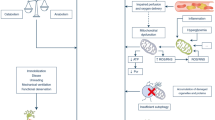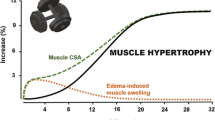Abstract
Importance
Intensive care unit (ICU)-acquired muscle wasting is a devastating complication leading to persistent weakness and functional disability. The mechanisms of this myopathy are unclear, but a disturbed balance of myosin heavy chain (MyHC) is implicated.
Objective
To investigate pathways of myosin turnover in severe critically ill patients at high risk of ICU-acquired weakness.
Design
Prospective, mechanistic, observational study.
Setting
Interdisciplinary ICUs of a university hospital.
Participants
Twenty-nine patients with Sequential Organ Failure Assessment (SOFA) scores of at least 8 on three consecutive days within the first 5 days in ICU underwent two consecutive open skeletal muscle biopsies from the vastus lateralis at median days 5 and 15. Control biopsy specimens were from healthy subjects undergoing hip-replacement surgery.
Interventions
None.
Main outcome(s) and measure(s)
Time-dependent changes in myofiber architecture, MyHC synthesis, and degradation were determined and correlated with clinical data.
Results
ICU-acquired muscle wasting was characterized by early, disrupted myofiber ultrastructure followed by atrophy of slow- and fast-twitch myofibers at later time points. A rapid decrease in MyHC mRNA and protein expression occurred by day 5 and persisted at day 15 (P < 0.05). Expression of the atrophy genes MuRF-1 and Atrogin1 was increased at day 5 (P < 0.05). Early MuRF-1 protein content was closely associated with late myofiber atrophy and the severity of weakness.
Conclusions and relevance
Decreased synthesis and increased degradation of MyHCs contribute to ICU-acquired muscle wasting. The rates and time frames suggest that pathogenesis of muscle failure is initiated very early during critical illness. The persisting reduction of MyHC suggests that sustained treatment is required.





Similar content being viewed by others
References
De Jonghe B, Sharshar T, Lefaucheur JP, Authier FJ, Durand-Zaleski I, Boussarsar M, Cerf C, Renaud E, Mesrati F, Carlet J, Raphael JC, Outin H, Bastuji-Garin S (2002) Paresis acquired in the intensive care unit: a prospective multicenter study. JAMA 288:2859–2867
Jaber S, Jung B, Matecki S, Petrof BJ (2011) Clinical review: ventilator-induced diaphragmatic dysfunction—human studies confirm animal model findings! Crit Care 15:206
Tobin MJ, Laghi F, Jubran A (2010) Narrative review: ventilator-induced respiratory muscle weakness. Ann Intern Med 153:240–245
Herridge MS, Cheung AM, Tansey CM, Matte-Martyn A, Diaz-Granados N, Al-Saidi F, Cooper AB, Guest CB, Mazer CD, Mehta S, Stewart TE, Barr A, Cook D, Slutsky AS (2003) One-year outcomes in survivors of the acute respiratory distress syndrome. N Engl J Med 348:683–693
Cheung AM, Tansey CM, Tomlinson G, Diaz-Granados N, Matte A, Barr A, Mehta S, Mazer CD, Guest CB, Stewart TE, Al-Saidi F, Cooper AB, Cook D, Slutsky AS, Herridge MS (2006) Two-year outcomes, health care use, and costs of survivors of acute respiratory distress syndrome. Am J Respir Crit Care Med 174:538–544
Bierbrauer J, Koch S, Olbricht C, Hamati J, Lodka D, Schneider J, Luther-Schroder A, Kleber C, Faust K, Wiesener S, Spies CD, Spranger J, Spuler S, Fielitz J, Weber-Carstens S (2012) Early type II fiber atrophy in intensive care unit patients with nonexcitable muscle membrane. Crit Care Med 40:647–650
Helliwell TR, Wilkinson A, Griffiths RD, McClelland P, Palmer TE, Bone JM (1998) Muscle fibre atrophy in critically ill patients is associated with the loss of myosin filaments and the presence of lysosomal enzymes and ubiquitin. Neuropathol Appl Neurobiol 24:507–517
Gruther W, Benesch T, Zorn C, Paternostro-Sluga T, Quittan M, Fialka-Moser V, Spiss C, Kainberger F, Crevenna R (2008) Muscle wasting in intensive care patients: ultrasound observation of the M. quadriceps femoris muscle layer. J Rehabil Med 40:185–189
Poulsen JB, Rose MH, Jensen BR, Moller K, Perner A (2013) Biomechanical and nonfunctional assessment of physical capacity in male ICU survivors. Crit Care Med 41:93–101
Callahan LA, Supinski GS (2009) Hyperglycemia and acquired weakness in critically ill patients: potential mechanisms. Crit Care 13:125
Winkelman C (2010) The role of inflammation in ICU-acquired weakness. Crit Care 14:186
Weber-Carstens S, Deja M, Koch S, Spranger J, Bubser F, Wernecke KD, Spies CD, Spuler S, Keh D (2010) Risk factors in critical illness myopathy during the early course of critical illness: a prospective observational study. Crit Care 14:R119
Klaude M, Mori M, Tjader I, Gustafsson T, Wernerman J, Rooyackers O (2012) Protein metabolism and gene expression in skeletal muscle of critically ill patients with sepsis. Clin Sci (Lond) 122:133–142
Lecker SH (2003) Ubiquitin-protein ligases in muscle wasting: multiple parallel pathways? Curr Opin Clin Nutr Metab Care 6:271–275
Goldberg AL (2003) Protein degradation and protection against misfolded or damaged proteins. Nature 426:895–899
Lecker SH, Solomon V, Mitch WE, Goldberg AL (1999) Muscle protein breakdown and the critical role of the ubiquitin–proteasome pathway in normal and disease states. J Nutr 129:227S–237S
Levine S, Biswas C, Dierov J, Barsotti R, Shrager JB, Nguyen T, Sonnad S, Kucharchzuk JC, Kaiser LR, Singhal S, Budak MT (2011) Increased proteolysis, myosin depletion, and atrophic AKT–FOXO signaling in human diaphragm disuse. Am J Respir Crit Care Med 183:483–490
Levine S, Nguyen T, Taylor N, Friscia ME, Budak MT, Rothenberg P, Zhu J, Sachdeva R, Sonnad S, Kaiser LR, Rubinstein NA, Powers SK, Shrager JB (2008) Rapid disuse atrophy of diaphragm fibers in mechanically ventilated humans. N Engl J Med 358:1327–1335
Puthucheary ZA, Rawal J, McPhail M, Connolly B, Ratnayake G, Chan P, Hopkinson NS, Padhke R, Dew T, Sidhu PS, Velloso C, Seymour J, Agley CC, Selby A, Limb M, Edwards LM, Smith K, Rowlerson A, Rennie MJ, Moxham J, Harridge SD, Hart N, Montgomery HE (2013) Acute skeletal muscle wasting in critical illness. JAMA 310:1591–1600
Bodine SC, Latres E, Baumhueter S, Lai VK, Nunez L, Clarke BA, Poueymirou WT, Panaro FJ, Na E, Dharmarajan K, Pan ZQ, Valenzuela DM, DeChiara TM, Stitt TN, Yancopoulos GD, Glass DJ (2001) Identification of ubiquitin ligases required for skeletal muscle atrophy. Science 294:1704–1708
Lecker SH, Jagoe RT, Gilbert A, Gomes M, Baracos V, Bailey J, Price SR, Mitch WE, Goldberg AL (2004) Multiple types of skeletal muscle atrophy involve a common program of changes in gene expression. FASEB J 18:39–51
Sacheck JM, Hyatt JP, Raffaello A, Jagoe RT, Roy RR, Edgerton VR, Lecker SH, Goldberg AL (2007) Rapid disuse and denervation atrophy involve transcriptional changes similar to those of muscle wasting during systemic diseases. FASEB J 21:140–155
Fielitz J, Kim MS, Shelton JM, Latif S, Spencer JA, Glass DJ, Richardson JA, Bassel-Duby R, Olson EN (2007) Myosin accumulation and striated muscle myopathy result from the loss of muscle RING finger 1 and 3. J Clin Invest 117:2486–2495
Derde S, Hermans G, Derese I, Guiza F, Hedstrom Y, Wouters PJ, Bruyninckx F, D’Hoore A, Larsson L, Van den Berghe G, Vanhorebeek I (2012) Muscle atrophy and preferential loss of myosin in prolonged critically ill patients. Crit Care Med 40:79–89
Wollersheim T, Woehlecke J, Krebs M, Hamati J, Lodka D, Langhans C, Luther-Schroeder A, Haas K, Rathke T, Kleber C, Spies C, Labeit S, Schuelke M, Spuler S, Spranger J, Weber-Carstens S, Fielitz J (2013) Rapid myosin loss in intensive care unit acquired weakness. Intensive Care Med 39:228
Wollersheim T, Weber-Carstens S, Egbers C, Luther A, Krebs M, Hamati J, Lodka D, Kleber C, Spies C, Spuler S, Fielitz J (2012) Dynamics of skeletal muscle atrophy and atrophy gene expression in critically ill patients during ICU stay. Intensive Care Med 38:130
Weber-Carstens S, Koch S, Spuler S, Spies CD, Bubser F, Wernecke KD, Deja M (2009) Nonexcitable muscle membrane predicts intensive care unit-acquired paresis in mechanically ventilated, sedated patients. Crit Care Med 37:2632–2637
Kim MS, Fielitz J, McAnally J, Shelton JM, Lemon DD, McKinsey TA, Richardson JA, Bassel-Duby R, Olson EN (2008) Protein kinase D1 stimulates MEF2 activity in skeletal muscle and enhances muscle performance. Mol Cell Biol 28:3600–3609
Eikermann M, Latronico N (2013) What is new in prevention of muscle weakness in critically ill patients? Intensive Care Med 39:2200–2203
Du J, Wang X, Miereles C, Bailey JL, Debigare R, Zheng B, Price SR, Mitch WE (2004) Activation of caspase-3 is an initial step triggering accelerated muscle proteolysis in catabolic conditions. J Clin Invest 113:115–123
Tidball JG, Spencer MJ (2002) Expression of a calpastatin transgene slows muscle wasting and obviates changes in myosin isoform expression during murine muscle disuse. J Physiol 545:819–828
Smith IJ, Alamdari N, O’Neal P, Gonnella P, Aversa Z, Hasselgren PO (2010) Sepsis increases the expression and activity of the transcription factor Forkhead Box O 1 (FOXO1) in skeletal muscle by a glucocorticoid-dependent mechanism. Int J Biochem Cell Biol 42:701–711
Sandri M, Sandri C, Gilbert A, Skurk C, Calabria E, Picard A, Walsh K, Schiaffino S, Lecker SH, Goldberg AL (2004) Foxo transcription factors induce the atrophy-related ubiquitin ligase atrogin-1 and cause skeletal muscle atrophy. Cell 117:399–412
Ciechanover A (2006) The ubiquitin proteolytic system: from a vague idea, through basic mechanisms, and onto human diseases and drug targeting. Neurology 66:S7–S19
Weber-Carstens S, Schneider J, Wollersheim T, Assmann A, Bierbrauer J, Marg A, Al Hasani H, Chadt A, Wenzel K, Koch S, Fielitz J, Kleber C, Faust K, Mai K, Spies CD, Luft FC, Boschmann M, Spranger J, Spuler S (2012) Critical illness myopathy and GLUT4—significance of insulin and muscle contraction. Am J Respir Crit Care Med 187:387–396
Moriscot AS, Baptista IL, Bogomolovas J, Witt C, Hirner S, Granzier H, Labeit S (2010) MuRF1 is a muscle fiber-type II associated factor and together with MuRF2 regulates type-II fiber trophicity and maintenance. J Struct Biol 170:344–353
Crossland H, Constantin-Teodosiu D, Gardiner SM, Constantin D, Greenhaff PL (2008) A potential role for Akt/FOXO signalling in both protein loss and the impairment of muscle carbohydrate oxidation during sepsis in rodent skeletal muscle. J Physiol 586:5589–5600
Dardevet D, Sornet C, Taillandier D, Savary I, Attaix D, Grizard J (1995) Sensitivity and protein turnover response to glucocorticoids are different in skeletal muscle from adult and old rats. Lack of regulation of the ubiquitin-proteasome proteolytic pathway in aging. J Clin Invest 96:2113–2119
Minneci PC, Deans KJ, Banks SM, Eichacker PQ, Natanson C (2004) Meta-analysis: the effect of steroids on survival and shock during sepsis depends on the dose. Ann Intern Med 141:47–56
Griffiths RD, Hall JB (2010) Intensive care unit-acquired weakness. Crit Care Med 38:779–787
Ali NA, O’Brien JM Jr, Hoffmann SP, Phillips G, Garland A, Finley JC, Almoosa K, Hejal R, Wolf KM, Lemeshow S, Connors AF Jr, Marsh CB (2008) Acquired weakness, handgrip strength, and mortality in critically ill patients. Am J Respir Crit Care Med 178:261–268
Kress JP, Herridge MS (2012) Medical and economic implications of physical disability of survivorship. Semin Respir Crit Care Med 33:339–347
Unroe M, Kahn JM, Carson SS, Govert JA, Martinu T, Sathy SJ, Clay AS, Chia J, Gray A, Tulsky JA, Cox CE (2010) One-year trajectories of care and resource utilization for recipients of prolonged mechanical ventilation: a cohort study. Ann Intern Med 153:167–175
Acknowledgments
We are thankful for the patience and courage of our patients and their consenting relatives. We thank Anika Lindner and Josefine Russ for technical assistance. We thank Friedrich C. Luft, MD, FACP for his continued support and editorial assistance. The Deutsche Forschungsgemeinschaft (FI 965/2-1, FI 965/4-1 and La668/14-1, KFO 192—WE 4386/1-2), Muscular Dystrophy Association, Marie Curie International Reintegration grant (FP7-PEOPLE-2007-4-3-IRG), and the Deutsche Gesellschaft für Muskelkranke supported this work.
Conflicts of interest
The authors are not aware of any conflicts of interest.
Author information
Authors and Affiliations
Corresponding author
Additional information
T. Wollersheim and J. Woehlecke contributed equally to this work.
S. Weber-Carstens and J. Fielitz contributed equally to this work.
Take-home message: Intensive care unit (ICU)-acquired muscle wasting is a devastating complication leading to persistent weakness and functional disability. We demonstrate that decreased synthesis and increased degradation of myosin heavy chains contribute to ICU-acquired muscle wasting, and conclude that therapeutic interventions must be initiated very early during critical illness.
Trial registration
The study was registered at http://www.controlled-trials.com as ISRCTN77569430.
Electronic supplementary material
Below is the link to the electronic supplementary material.
Rights and permissions
About this article
Cite this article
Wollersheim, T., Woehlecke, J., Krebs, M. et al. Dynamics of myosin degradation in intensive care unit-acquired weakness during severe critical illness. Intensive Care Med 40, 528–538 (2014). https://doi.org/10.1007/s00134-014-3224-9
Received:
Accepted:
Published:
Issue Date:
DOI: https://doi.org/10.1007/s00134-014-3224-9




